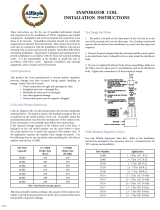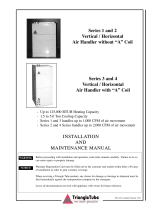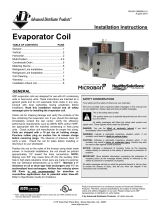
0673567-00 / 507795-01 Issue 1810 Page 3 of 8
If the coil is located in or above a living space where
damage may result from condensate overow, a
separate ¾″ drain must be provided from the secondary
drain connection (or a Float Switch can be used - refer
to kit instructions for installation procedures). Run this
drain to a place in compliance with local installation
codes where it will be noticed when unit is operational.
Condensate owing from the secondary drain indicates
a plugged primary drain.
Prime the trap with water. Test line for leaks. Verify
water ow with unit in operation.
CAUTION
Wiring
Electric shock hazard. Can cause injury or death. Before
attempting to perform any service or maintenance,
turn the electrical power to the unit OFF at disconnect
switch(es). Unit may have multiple power supplies.
DANGER
Use Copper Conductors Only
WARNING
Run 24V Class 11 wiring only through the specied
low voltage opening. Run the line voltage wiring only
through the specied high voltage opening. Do not
combine Voltage in one opening.
WARNING
Wiring must conform to the current National Electric Code
ANSI/NFPA No. 70, or Canadian Electric Code Part 1, CSA
Standard C22.1, and local electric codes. See the unit
nameplate for minimum circuit ampacity and maximum
overcurrent protection size.
Select the proper supply circuit conductors according to
tables 310-16 and 310-17 in the National Electric Code,
ANSI/NFPA NO. 70 or Tables 1-–4 in the Canadian Electric
Code, Part 1, CSA Standard C22.1.
Refrigerant Piping
Coil refrigerant connections are 3/8″ ODF Liquid and
3/4″ ODF Suction. Refer to outdoor unit manufacturer’s
recommendation on line sizing.
During brazing of refrigerant lines place a wet rag around
suction line on top of cabinet to protect cabinet from
overheating. Maintain a minimum of 1.5″ from cabinet and
refrigerant brazing connections.
Refrigerant Flow Controls
Refer to nomenclature to determine type of ow control
installed and needed for your application. Evaporator coils
are shipped from the factory with orator pistons or TXV
assemblies. Florator pistons and TXV kits are available for
eld conversion.
Pistons
As shipped from the factory, the piston installed in each coil
is chosen for the nominal BTUH capacity of the coil. Verify
with the condenser recommendation that proper orator
piston is selected. Replace the piston per the outdoor unit
instructions.
When changing pistons use the following procedure:
1. Loosen hex nut located on liquid line and separate
from distributor assembly.
2. Remove the existing piston from inside the distributor
assembly
3. Insert the desired piston into the distributor assembly.
4. Replace “O” ring with a new one.
5. Re-install hex nut to body and torque to 10 ft-lbs.
Thermal Expansion Valves
As shipped from the factory, the TXV installed in each coil
is chosen for the nominal BTUH capacity of the coil. Attach
and insulate the TXV bulb outside of the cabinet to the
main suction line no more than one foot from the suction
line connection. The bulb must be insulated.
Field installed TXV kits are also available. Refer to
engineering guide or price sheet for sizes, and kit
instructions for installation procedures.
Refrigerant Line Installation
Allied Air recommends installing a lter drier in the liquid
line, per outdoor unit instructions. While brazing, purge
the system with Nitrogen to prevent contamination. Attach
TXV bulb only after brazing line sets at a 10 to 2 o’clock
position on the suction line, outside the coil housing, no
more than one foot from the connection. Evacuate the
system to 500 microns to ensure proper air and moisture
removal (Note: Deep evacuation or triple evacuation
method recommended). Open the suction service valve
slowly and allow the refrigerant to bleed into the system
before opening the liquid service valve.
Refrigerant Charging
Refer to the outdoor unit instructions for proper system
charging.










